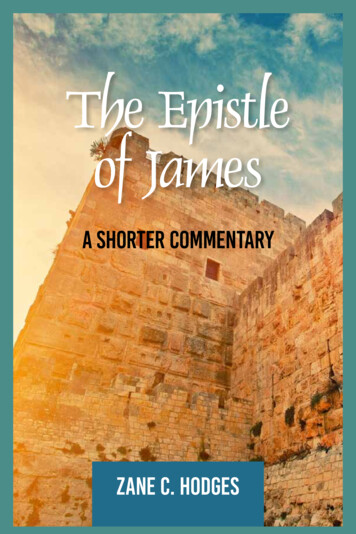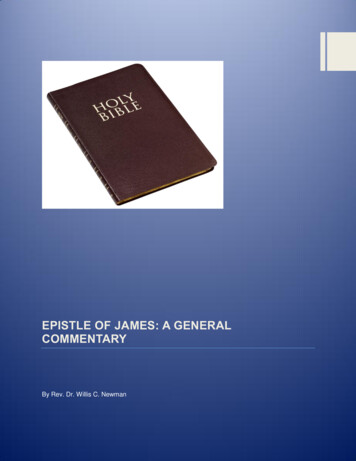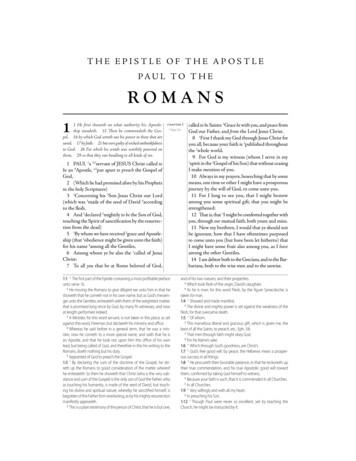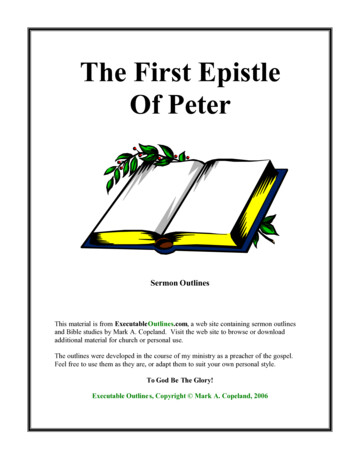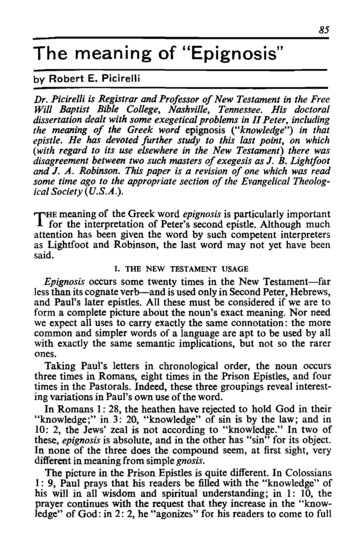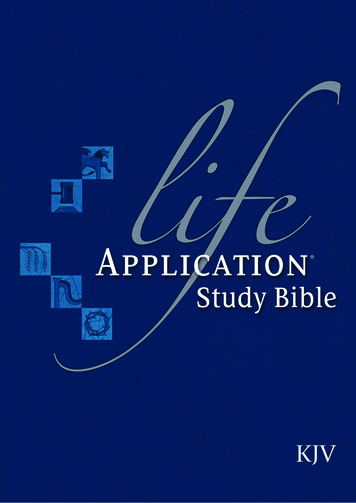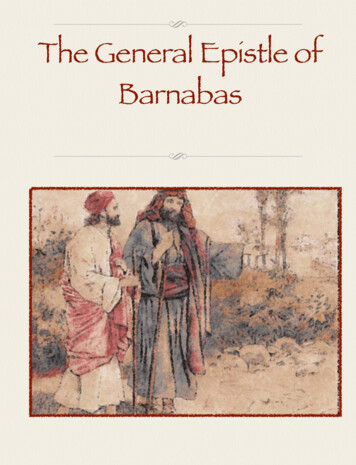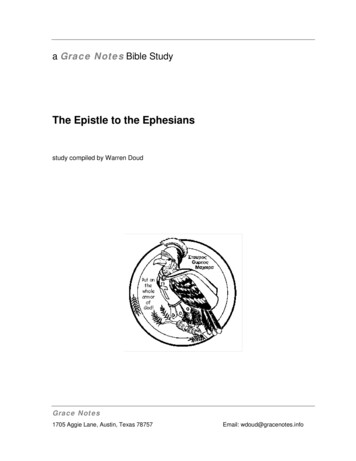
Transcription
a Grace Notes Bible StudyThe Epistle to the Ephesiansstudy compiled by Warren DoudGrace Notes1705 Aggie Lane, Austin, Texas 78757Email: wdoud@gracenotes.info
Epistle to the EphesiansTable of ContentsPreview to the Study of Ephesians . 4Ephesus . 6Ephesians, Chapter 1 . 10Ephesians, Chapter 2 . 26Ephesians, Chapter 3 . 39Ephesians, Chapter 4 . 55Ephesians, Chapter 5 . 85Ephesians, Chapter 6 . 102Categorical Studies (Word Studies and Doctrinal Topics). 117Adoption . 117Anger. 117Apostleship. 121Baptism . 122Bible Goals for Children . 124Bitterness . 127Blessing. 131Blood of Christ. 135Christian in the Workplace . 136Christian Worker Qualifications . 137Circumcision. 139Confession of Sin . 141Deity of Christ. 144Demons. 144Depression . 147Edification (Growing in Christ) . 152Essence of God. 156Evil. 167Faith . 176Fellowship . 181Forgiveness. 183Glory of God. 184Godliness . 187Gospel. 189Grace . 190Heavenlies . 202
Holy Spirit. 203Hope. 209Importance of Bible Teaching . 210Inheritance . 212Law of Moses . 213Levitical Priesthood . 216Mental Attitude . 218Music . 222Mystery. 231Negative Volition . 233Occupation with Christ . 233Paul the Apostle . 240Peace . 243Predestination . 244Reconciliation. 246Redeeming the Time. 247Redemption. 250Repentance. 254Resurrection of Christ . 258Salvation Doctrines . 263Salvation in the Old Testament. 266Satan . 268Separation. 272Servants and Slaves in Palestine . 274Servants of God . 276Shepherds of the Flock . 277Sin . 284Sin Nature . 294Sins of the Tongue . 294Suffering. 294Uncleanness in the Levitical System . 299Union (DAVAQ). 300Union with Christ . 302Volitional Responsibility . 303Walking, Christian . 304Witnessing. 309
Preview to the Study of EphesiansA reference book that is an essential in any study that involves the Apostle Paul, whether his epistlesor his activities and speeches in the Acts of the Apostles, is the masterful history "The Life andEpistles of St. Paul", written in the 19th Century by the Rev. W. J. Conybeare, MA, and the VeryRev. J. S. Howson, DD.For what it's worth, this is my all time favorite Christian publication! I have studied the book twiceand read parts of it many times.From the first paragraph of their introduction: "The purpose of this work is to give a living picture ofSt. Paul himself, and of the circumstances by which he was surrounded."Actually, they did far more than that modest sentence indicates. Either Conybeare or Howson (or bothof them) personally walked and sailed everywhere that the Apostle traveled! Their account is a greattravelogue, an historical tour-de-force, and an insightful Christian analysis and examination of Paul'sministry. Included in the book are the authors' own translations from the Greek of Paul's inspiredwritings! The excerpt below will give you an indication to the depth of thought and carefulconsideration that went into all their writing.New and used copies of “Conybeare and Howson” can be obtained from used book dealers online,and through Amazon.com or Barnes and Noble online book sellers.Warren Doud********************From "The Life and Epistles of St. Paul", by W. J. Conybeare and J. S. Howson, pp. 702-705These are Conybeare and Howson's introductory paragraphs to their translation of the Epistle to theEphesians."We have seen that the above Epistle to the Colossians, and that to Philemon, were conveyed byTychicus and Onesimus, who traveled together from Rome to Asia Minor. But these two were not theonly letters with which Tychicus was charged. We know that he carried a third letter also; but it is notequally certain to whom it was addressed. This third letter was that which is not entitled the Epistle tothe Ephesians; concerning the destination of which (disputed as it is) perhaps the least disputable factis, that it was not addressed to the Church of Ephesus."This point is established by strong evidence, both internal and external. To begin with the former, weremark, First, that it would be inexplicable that St. Paul, when he wrote to the Ephesians, amongstwhom he had spent so long a time, and to whom he was bound by ties of such close affection (Acts20:17, etc.), should not have a single message of personal greeting to send. Yet none are found in thisEpistle. Secondly, he could not have described the Ephesians as a church whose conversion he knewonly by report (1:15). Thirdly, he could not speak to them, as only knowing himself (the founder oftheir church) to be an apostle by hearsay (3:2), so as to need credentials to accredit him with them(3:4). Fourthly, he could not describe the Ephesians as so exclusively Gentiles (2:11; 4:17), and sorecently converted (5:8; 1:13; 2:13)."This internal evidence is confirmed by the following external evidence also.1. St. Basil distinctly asserts, that the early writers whom he had consulted declared that themanuscripts of this Epistle in their time did not contain the name of Ephesus, but left out altogether
the name of the church to which the Epistle was addressed. He adds, that the most ancientmanuscripts which he had himself seen gave the same testimony. This assertions of Basil's isconfirmed by Jerome, Epiphanius, and Tertullian.2. The most ancient manuscript now known to exist, namely, that of the Vatican Library, fully bearsout Basil's words; for in its text it does not contain the words 'in Ephesus' at all; and they are onlyadded in its margin by a much later hand.3. We know, from the testimony of Marcion, that this Epistle was entitled in his collection 'TheEpistle to the Laodiceans.' And his authority on this point is entitled to greater weight from the fact,that he was himself a native of the district where we should expect the earlier copies of the Epistle toexist."The above arguments have convinced the ablest modern critics that this Epistle was not addressed tothe Ephesians. But there has not been by any means the same approach to unanimity on the question,who were its intended readers."In the most ancient manuscripts no church is mentioned by name, except in those consulted byMarcion, according to which it was addressed to the Laodiceans. Now the internal evidence abovementioned proves that the Epistle was addressed to some particular church or churches, who were toreceive intelligence of St. Paul through Tychicus, and that it was not a treatise addressed to the wholeChristian world; and the form of the salutation shows that the name of some place must originallyhave been inserted in it."Again: the very passages in the Epistle which have been above referred to, as proving that it couldnot have been directed to the Ephesians, agree perfectly with the hypothesis that it was addressed tothe Laodiceans. Lastly, we know from the Epistle to the Colossians, that St. Paul did write a letter toLaodicea (Col. 4:16) about the same time with that to Colosse. On these grounds, then, it appears thesafest course to assume that the testimony of Marcion (uncontradicted by any other positive evidence)is correct, and that Laodicea was one at least of the churches to which this Epistle was addressed.And, consequently, as we know not the name of any other church to which it was written, that ofLaodicea should be inserted in the place which the most ancient manuscripts leave vacant."Still, it must be obvious, that this does not remove all the difficulties of the question. For, first it willbe asked, how came the name of Laodicea (if originally inserted) to have slipped out of these ancientmanuscripts? And again, how came it that the majority of more recent manuscripts inserted the nameof Ephesus? These perplexing questions are in some measure answered by the hypothesis advancedby Archbishop Ussher, that this Epistle was a circular letter, addressed to not one only, but to severalchurches, in the same way as the Epistle to the Galatians was addressed to all the churches in Galatia,and those to Corinth were addressed to the Christians 'in the whole province of Achaia.'"On this view, Tychicus would have carried several copies of it, differently superscribed, one forLaodicea, another, perhaps, for Hierapolis, another for Philadelphia, and so on. Hence the earlycopyists, perplexed by this diversity in their copies, might many of them be led to omit the words inwhich the variation consisted: and thus the state of the earliest known text of the Epistle would beexplained."Afterwards, however, as copies of the Epistle became spread over the world, all imported fromEphesus (the commercial capital of the district where the Epistle was originally circulated), it wouldbe called (in default of any other name) the Epistle from Ephesus; and the manuscripts of it would beso entitled; and thence the next step, of inserting the name of Ephesus into the text, in a place wheresome local designation was plainly wanted, would be a very easy one. And this designation of the
Epistle would the more readily prevail, from the natural feeling that St. Paul must have written someEpistle to so great a church of his own founding as Ephesus."Thus the most plausible account of the origin of this Epistle seems to be as follows. Tychicus wasabout to take his departure from Rome for Asia Minor. St. Paul had already written his Epistle to theColossians at the request of Epaphras, who had informed him of their danger. But Tychicus was aboutto visit other places, which, though not requiring the same warning with Colosse, yet abounded inChristian converts. Most of these had been heathens, and their hearts might be cheered andstrengthened by words addressed directly to themselves from the great Apostle of the Gentiles, whoseface they had never seen, but whose name they had learned to reverence, and whose sufferings hadendeared him to their love."The scattered churches (one of which was Laodicea) had very much in common, and would all bebenefited by the same instruction and exhortation. Since it was not necessary to meet the individualcase of any one of them, as distinct from the rest, St. Paul wrote the same letter to them all, but sent toeach a separate copy authenticated by the precious stamp of his own autograph benediction. And thecontents of this circular epistle naturally bore a strong resemblance to those of the letter which he hadjust concluded to the Colossians, because the thoughts which filled his heart at the time wouldnecessarily find utterance in similar language, and because the circumstances of these churches werein themselves very similar to those of the Colossian church, except that there were not infected withthe peculiar errors which had crept in at Colosse."The Epistle which he thus wrote consists of two parts: first, a doctrinal, and, secondly, a hortatoryportion. The first part contains a summary, very indirectly conveyed (chiefly in the form ofthanksgiving), of the Christian doctrines taught by St. Paul, and is especially remarkable for the greatprominence given to the abolition of the Mosaic Law. The hortatory part, which has been so dear toChristians of every age and country, enjoins unity (especially between Jewish and Gentile Christians),the renunciation of heathen vices, and the practice of Christian purity."It lays down rules (the same as those in the Epistle to Colosse, only in an expanded form) for theperformance of the duties of domestic life, and urges these new converts, in the midst of the perilswhich surrounded them, to continue steadfast in watchfulness and prayer. Such is the substance, andsuch was most probably the history, of the Epistle.[ End of quotation. ]EphesusThese materials on the history and geography of Ephesus were compiled from the following sources:Unger, Merrill F., Bible DictionaryEncyclopedia BritannicaBean, G. E., "Aegean Turkey: An Archaeological Guide"Conybeare and Howson, "The Life and Epistles of St. Paul"Ephesus, the most important Greek city in Ionian Asia Minor, the ruins of which lie near the modernvillage of Selcuk in western Turkey (near the city of Izmir).In Roman times it was situated on the northern slopes of the hills Coressus and Pion and south of theCayster (Küçükmenderes) River, the silt from which has since formed a fertile plain but has causedthe coastline to move ever farther west. The Temple of Artemis, or Diana, to which Ephesus owedmuch of its fame and which seems to mark the site of the classical Greek city, was probably on the
seaboard when it was founded (about 600 BC), one mile east by northeast of Pion (modern PanayirDaghacek). In Roman times a sea channel was maintained with difficulty to a harbor well west ofPion. By late Byzantine times this channel had become useless, and the coast by the mid-20th centurywas three miles farther west. Ephesus commanded the west end of one great trade route into Asia, thatalong the Cayster valley, and had easy access to the other two, along the Hermus (Gediz) and theMaeander (Büyükmenderes) rivers.HistoryEphesus enters history in the mid-7th century BC, when it was attacked by the Cimmerians. Unlike itsneighbor, Magnesia, it survived the attacks. For part of the early 6th century the city was undertyrants. Though allied by marriage to the kings of Lydia, its people could not hold back the LydianCroesus, who asserted a general suzerainty over the city. He did, however, present many columns andsome golden cows for a new and splendid rebuilding of the Artemiseum (Temple of Artemis).At this time, according to Strabo, the Ephesians began to live in the plain; and to this period, too,should be allotted the redrafting of the laws, said to have been the work of an Athenian, Aristarchus.Ephesus soon submitted to Cyrus of Persia. Early in the Ionian revolt (499-493 BC) against thePersians, Ephesus served as a base for an Ionian attack on Sardis; but it is not mentioned again until494, when the Ephesians massacred the Chiot survivors of the Battle of Lade. The massacre may haveoccurred because Ephesus was a commercial rival of the chief rebels, Chios and Miletus. Ephesusmaintained friendly relations with Persia for about 50 years: in 478 Xerxes, returning from his failurein Greece, honored Artemis of Ephesus, although he sacked other Ionian shrines, and left his childrenfor safety in Ephesus; andThemistocles landed there in the 460s on his flight to Persia. But after 454 Ephesus appears as aregular tributary of Athens. Great Ephesians up to this time had been Callinus, the earliest Greekelegist (mid-7th century BC), the satirist Hipponax, and the famous philosopher Heracleitus, one ofthe Basilids.Ephesus shared in a general revolt of 412 BC against Athens, siding with Sparta in the SecondPeloponnesian War, and remained an effective ally of Sparta down to the end of the war. Threatenedby Persia after 403, Ephesus served in 396 as the headquarters of King Agesilaus of Sparta. In 394 theEphesians deserted to Conon's anti-Spartan maritime league, but by 387 the city was again in Spartanhands and was handed by Antalcidas to Persia. There followed the pro-Persian tyranny of Syrphaxand his family, who were stoned to death in 333 on Alexander the Great's taking the city. After 50years of fluctuating fortune, Ephesus was conquered by the Macedonian general Lysimachus andresettled around Coressus and Pion (286-281 BC). Lysimachus introduced colonists from Lebedusand Colophon and renamed the city after his wife, Arsinoo--a name soon dropped. This was thebeginning of Ephesus' Hellenistic prosperity. It became conspicuous for the abundance of its coinage.After the defeat of Antiochus the Great, king of Syria, by the Romans in 189 BC, Ephesus washanded over by the conquerors to the king of Pergamum. Attalus III of Pergamum bequeathedEphesus with the rest of his possessions to the Roman people (133 BC). Thenceforth, Ephesusremained subject to Rome, except for a brief time beginning in 88 BC, when, at the instigation ofMithradates the Great of Pontus, the cities of Asia Minor revolted and killed their Roman residents.The Ephesians even killed those Romans who had fled for refuge to the Artemiseum; notwithstandingwhich they returned in 86 BC to their former masters. Their claim, preserved on an extant inscription,that in admitting Mithradates they had merely yielded to superior force was rudely brushed aside bySulla, who inflicted a very heavy fine. Although it twice chose the losing side in the Roman civil warsand although it was stoutly opposed by Pergamum and Smyrna, Ephesus became under Augustus thefirst city of the Roman province of Asia. The geographer Strabo wrote of its importance as a
commercial center in the 1st century BC. The triumphal arch of 3 BC and the aqueduct of AD 4-14initiated that long series of public buildings, ornamental and useful, that make Ephesus the mostimpressive example in Greek lands of a city of imperial times.Meanwhile the Christian Church began to win converts. A famous protest in the theatre against theteachings of St. Paul, described in Acts 19, is dated about AD 57. According to local belief Ephesuswas the last home of the Virgin Mary, who was lodged near the city by St. John and died there. Thetradition that St. Luke also died there seems to be less strongly supported. Ephesus was one of theseven churches of Asia to which the Revelation to John was addressed.The Goths destroyed both city and temple in AD 262, and neither ever recovered its former splendor.The emperor Constantine, however, erected a new public bath, and Arcadius rebuilt at a higher levelthe street from the theatre to the harbor, named after him, the Arkadiane. A general council of thechurch, held at Ephesus in 431 in the great double church of St. Mary, condemned Nestorius andjustified the cult of the Virgin as Theotokos (Mother of God). A few years later, according to legend,the Seven Sleepers of Ephesus (a group of 3rd-century Christian martyrs) were miraculously raisedfrom the dead. They too became the object of a famous cult. The emperor Justinian built themagnificent basilica of St. John in the 6th century. By the early Middle Ages, the city was no longeruseful as a port and fell into decline; late Byzantine Ephesus, conquered by the Seljuqs in 1090, wasmerely a small town. After brief splendor in the 14th century, even this was deserted, and the true siteof the Artemiseum remained unsuspected until 1869.Excavations and extant remains.J. T. Wood, working at Ephesus for the British Museum between 1863 and 1874, excavated theodeum and theatre. In May 1869 he struck a corner of the Artemiseum. His excavation exposed toview not only the scanty remains of the latest edifice (built after 350 BC) but the platform below it ofan earlier temple of identical size and plan subsequently found to be that of the 6th century BC, towhich Croesus contributed. The sculptured fragments of both temples were sent to the BritishMuseum. In 1904 D.G. Hogarth, heading another mission from the museum, examined the earlierplatform and found beneath its center the remains of three yet older structures. In its earliest knownphase the temple was apparently a small platform of green schist, containing a sealed deposit ofprimitive coins and other objects. These date from c. 600 BC.It is impossible to assign the various architects named by ancient authors to the respective phases ofthe temple. At best, Chersiphron and Metagenes can be tentatively assigned to the Temple of Croesus,Chirocrates or Dinocrates to that of the 4th century. There had perhaps been some repairs toward 400BC, associated with the architects Paeonius and Demetrius and with the prize-winning dedicatoryhymn of the famous musician Timotheus. The Artemiseum passed rapidly through three phasesbefore c. 550 BC. The Temple of Croesus (the fourth phase) was remarkable for its great size (it wasmore than 300 feet long and 150 feet wide), for the carved figures around the lower drums of itscolumns (columnae caelatae), and for the smaller but elaborate figured friezes along its roof gutter(sima). Croesus' temple seems to have been burned down in 356 BC. The new temple built shortlyafterward copied the old in its columnae caelatae, one of which was by Scopas; but the new sima,instead of small, crowded figures, had a more conventional, if vigorous, rinceau ornament. The cellacontained, among other great works, the Amazons of Polyclitus, Phidias, and Cresilas.Lysimachean Ephesus has been continuously excavated since 1894 by the Austrian ArchaeologicalInstitute, but so solid and extensive is the Roman town that by the early 1960s the Austrians hadrarely penetrated to Hellenistic levels.
On the hill of Ayasoluk (Hagios Theologos) is Justinian's church of St. John the Theologian, builtaround a shrine variously associated in the early Middle Ages with the death or bodily assumption ofSt. John. The church, uncovered since 1922, is a noble structure but badly restored. On the hill thereis also a beautiful Seljuq mosque dedicated in 1375.The public buildings of the city are arranged in a rectangular street pattern going back to Hellenisticdays. They include the theatre, capable of seating nearly 25,000 spectators and completed in itspresent form under Trajan; the agora (marketplace), surrounded by stoas (sheltered promenades),dating from the time of Severus; the library of Celsus, also Trajanic and well known because of itsfacade; and an immen
Preview to the Study of Ephesians A reference book that is an essential in any study that involves the Apostle Paul, whether his epistles or his activities and speeches in the Act
